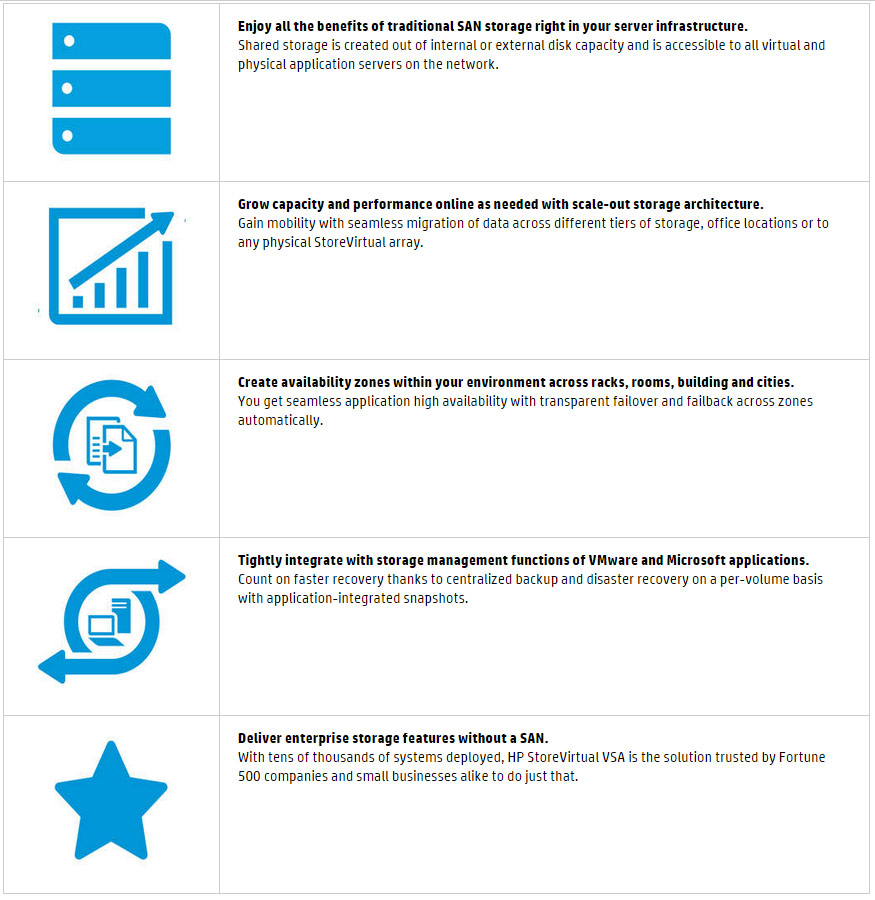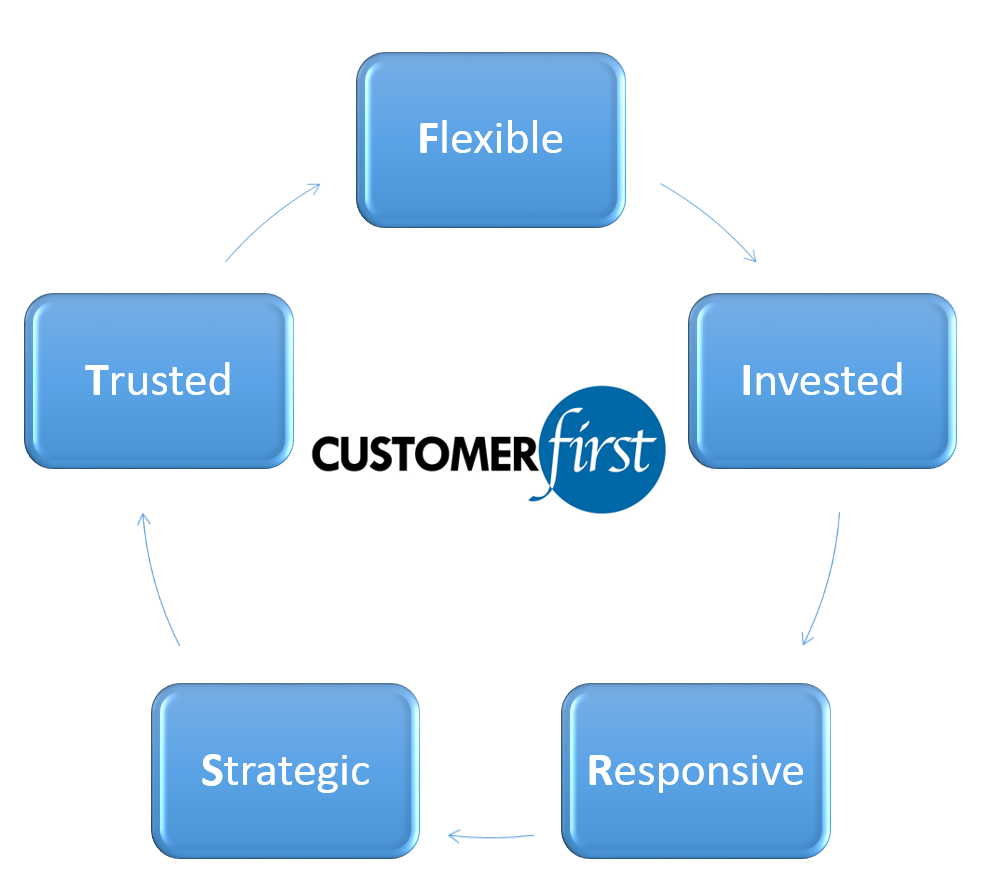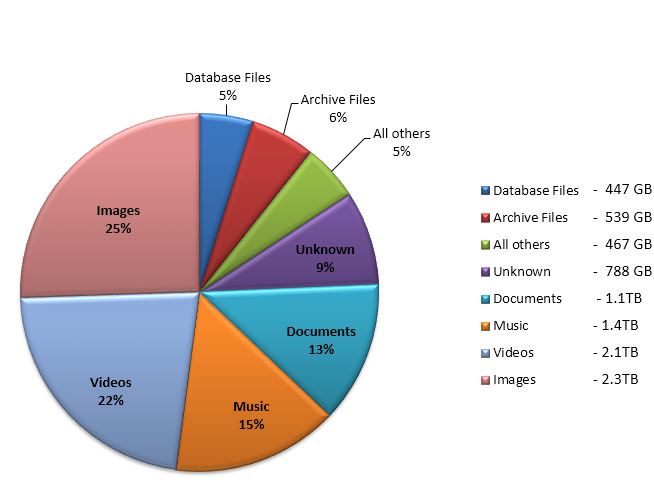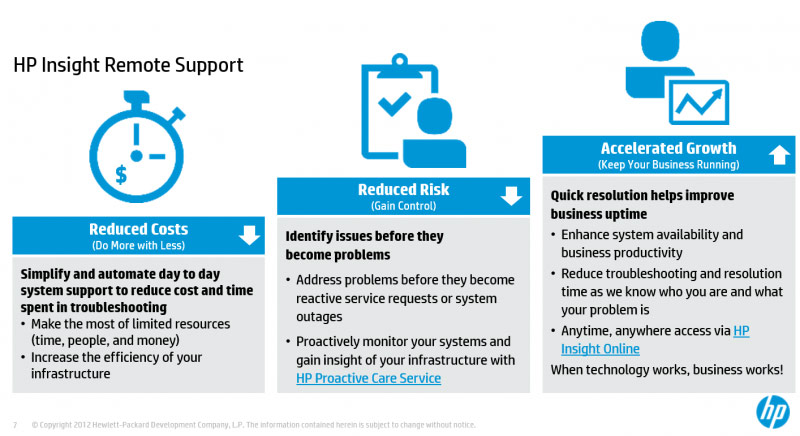The vendor world is not particularly gifted at letting the rest of the world know when they have specials taking place. Today I would like to rectify that situation and focus on a fantastic deal that HPE has for their ProLiant servers, an additional value-add included with each Intel Xeon server purchased.
HPE, for no additional cost, is giving clients a 1TB license of HPE StoreVirtual VSA (Virtual SAN Appliance) software with all Intel Xeon-based HP ProLiant DL, BL, and ML series servers. Essentially, VSA is a virtual machine which can utilize “captive” internal unused disk installed in a server. This storage with VSA software can appear as an iSCSI SAN which can then be used by other servers or virtual machines.
The HPE StoreVirtual VSA technology is based on LeftHand OS (a well-known and a very mature storage operating environment). If two or more VSAs are installed (on different servers), a fault-tolerant storage environment can be created, as the Lefthand OS software is fully featured and includes such technologies as snapshots, replication, thin provisioning, etc.
HPE StoreVirtual VSA is just a part of HPE’s Software-Defined Storage initiatives, including VSA-powered deduplication appliances (StoreOnce VSA), and hooks into the industry’s leading virtual machine backup tool, Veeam.

Configured in just minutes, HPE ProLiant Gen9 servers, which now feature an integrated single-click VSA deployment, can easily be up and running with an operating system and VSA software to support virtualized applications and shared storage on the same hardware.
Unfortunately, if your server was purchased prior to this promotion, or there is no “coupon code sticker” on your server, but you can trial this storage software for 60 days to see if it would fit your needs.
If you like what you see with this promo or need more capacity capability, even in your older/existing servers, please contact Zunesis for a quote or for more information.
See what you gain with HPE StoreVirtual VSA!
[qodef_button size=”small” type=”default” text=”More Information” custom_class=”” icon_pack=”font_awesome” fa_icon=”” link=”http://www8.hp.com/us/en/products/data-storage/server-vsa.html” target=”_blank” color=”#ffffff” hover_color=”#004f95″ background_color=”#30c7ff” hover_background_color=”#ffffff” border_color=”#30c7ff” hover_border_color=”#004f95″ font_size=”” font_weight=”” margin=””]
[qodef_button size=”small” type=”default” text=”Product Datasheet” custom_class=”” icon_pack=”font_awesome” fa_icon=”” link=”http://h20195.www2.hp.com/V2/GetDocument.aspx?docname=4AA5-5143ENW&cc=us&lc=en” target=”_blank” color=”#ffffff” hover_color=”#004f95″ background_color=”#30c7ff” hover_background_color=”#ffffff” border_color=”#30c7ff” hover_border_color=”#004f95″ font_size=”” font_weight=”” margin=””]
In my last blog, we explored the Customer Service Pillar of being Responsive in the context of what customers are expecting from the IT Solution providers today. As a reminder, I am writing from a customer service roadmap called CustomerFIRST where the word FIRST is an acrostic.
 This week I am addressing the 4th Pillar of successful customer service – being Strategic.
This week I am addressing the 4th Pillar of successful customer service – being Strategic.
When I was a young IT sales professional in my 20’s, I learned a very important lesson from a wise Chief Information Officer (CIO) who decided to invest in my development. The story I am about to tell is true, but the names have been omitted to protect the innocent. After 2 years of hard work, we had established our company as a strategic provider of IT Solutions for one of the largest railroads in America. I had developed a strong trust-based relationship with the CIO and she was an outspoken positive reference for our work.
I took my hard fought experiences and reached out to the CIO of another large railroad. After an exhaustive “never give up” cold calling campaign, I wore the poor CIO down and he agreed to meet with me. As my airplane touched down in the city where this railroad was headquartered, I could feel my excitement building. You see, I had so much to share with this CIO. I arrived 30 minutes early wearing a dark suit and my power tie. As I waited outside his office, I reviewed in my mind what I had rehearsed and prepared. Promptly at 11 a.m., I was escorted in to a large office where Mr. CIO sat behind his desk looking very professional and somewhat intimidating.
We exchanged some pleasantries about the weather and a recent football game, and then I began my pitch. My confidence level was at an all-time high, and the words flowed from my mouth like a beautiful river. The CIO seemed to be listening to everything I said; and he would occasionally nod and say, “You don’t say.” I ended my discussion with my closing statement, “As you can see, we have proven technical expertise in all of these important areas; and we could do the same magic for you!”
For the first time in 30 minutes, I was silent. The CIO looked at me and said “Steve, I really appreciate you taking the time to come all the way out here to meet with me and tell me about all the wonderful things you are doing for another railroad. To be candid, we don’t have a need for any of the technologies or solutions you just presented.” With that, he walked me to the door and said, “My assistant will show you out.” I was dumbfounded and in a state of shock. My delivery was perfect and my discussions focused on the railroad industry. What the heck?
Two days later, back in Colorado, I picked up the phone and called Mr. Railroad CIO who graciously agreed to talk with me. I simply wanted to know what happened. Mr. Railroad CIO shared with me that he purposely showed me the door to teach me a lesson that he hoped would benefit me throughout my future life in business. He explained that my focus should always be on first seeking to understand the needs, desires and priorities of the client. He said, “It doesn’t matter what you have done, how you have done it or what you have accomplished, if it isn’t relevant to the needs of the client sitting in front of you.” He followed this with, “Never sell before you understand.” That experience has stuck with me since, and I thank Mr. Railroad CIO for his willingness to teach me an important lesson.
 Being strategic means being relevant; and being relevant can only happen if a customer’s needs, requirements, and business are clearly understood. Today, clients expect that their IT Solution Providers are investing in the process of learning their business, their culture, and their operations. Without this investment in knowledge, IT Solution Providers are throwing things against the proverbial wall and hoping something sticks. Too often, IT Solution Providers wait for their clients to request technology – hardware, software, solutions – and then they react and respond to those requests. This is a reactive model of service, and most IT Solution Providers fall into this bucket.
Being strategic means being relevant; and being relevant can only happen if a customer’s needs, requirements, and business are clearly understood. Today, clients expect that their IT Solution Providers are investing in the process of learning their business, their culture, and their operations. Without this investment in knowledge, IT Solution Providers are throwing things against the proverbial wall and hoping something sticks. Too often, IT Solution Providers wait for their clients to request technology – hardware, software, solutions – and then they react and respond to those requests. This is a reactive model of service, and most IT Solution Providers fall into this bucket.
While being responsive is important, as I discussed in my last blog, being proactive can lead to true customer service and loyalty. Imagine a conversation with a client that goes something like this:
“Mrs. Client, based on your key initiatives for the coming year and your focus on getting your IT staff up to speed on technology X, I thought you would benefit from this written case study of an implementation of this solution we recently did for another client. Let me know if you would like to talk about how we could help you in the same way.”
This proactive type of value can create huge separation between yourself and your competition and the sales process advances much more smoothly. All of this sounds like common sense, doesn’t it? Then why in the world are we, as an industry, not doing it more consistently?
Perhaps because it takes time. Being Strategic requires an investment of time and effort to learn about your customer in many areas:
- Current IT infrastructure, operations, and applications
- Key initiatives and priorities
- IT vision & strategy looking forward (future)
- Procurement, budgeting, approval process
- Current IT staff (expertise and experience)
- Culture
If an IT Solution Provider can share ideas, solutions, and technologies based on the actual needs and operational realities of a client, those ideas and solutions have a much greater chance of adding value to the client.Don’t make the mistake I made by “showing up and throwing up” without first doing your homework and investing in learning what really matters to the client. Your investment will separate you for the competition and create an opportunity to add relevant value to your client.
Next week we will explore the importance of being Trusted by our clients and the process to create the opportunity for a trust-based relationship.
Until we meet again, I wish you the very best in your efforts to serve customers in the ways they wish to be served.
As Information Technology (IT) professionals, we develop tunnel vision from time to time. Disaster Recovery (DR) planning is an area that tends to be a focal point of the aforementioned tunnel vision. IT professionals show a propensity to zero in on technology DR planning, working diligently to ensure primary data center services are recoverable and functioning in a timely manner after a disaster.
In doing so, they often forget that technology DR planning is just a piece of the larger Business Continuity (BC) planning. BC planning is the process of preparing to mitigate the damage caused by any disruption of normal business operations and ensure the return to normal functionality in as expedient and efficient a manner as possible.
VMware Site Recovery Manager (SRM) is a tool that can greatly assist with both types of planning through the automation of technology within VMware virtualized infrastructures. There are three very important things to know about VMware SRM.
-
- First, it is a tool to assist with the disaster recovery process. It is not a complete DR plan or process in and of itself.
-
- SRM can allow for the automated failover of virtual machines (VM’s) from the protected site to the recovery site.
- It provides the capability to automate the reconfiguration of many items for the protected VM’s, thus changing the IP configuration for the VM’s to be compatible with the recovery site’s IP address schema.
- It does not have the capability to change items eternal to virtual infrastructure, such as Internet domain name services and public IP addresses. When a failover to the recovery site does occur, the public IP address for that site will differ from the one used at the protected site. The tools and process used to facilitate this change are just one example of items that must be included within a complete DR plan – though VMware SRM is a useful tool; it cannot be used as an all-in-one strategy for DR.

-
- First, it is a tool to assist with the disaster recovery process. It is not a complete DR plan or process in and of itself.
-
- The second thing to know about VMware SRM is that it does not require the use of storage vendor array based replication (ABR).
-
- Vendor ABR solutions can provide a smaller recovery point object (RPO), a fancy way of saying that less operational data is lost, than VMware vSphere Replication (VR). Some vendor ABR’s can provide almost real-time RPO through synchronous replication.
- VMware VR, which is included with vSphere standard edition and up, can provide an RPO in windows as small as 15 minutes. For many organizations, a 15-minute RPO is acceptable, especially when balanced against the additional cost of vendor ABR solutions.
-
- The second thing to know about VMware SRM is that it does not require the use of storage vendor array based replication (ABR).
- Finally, the third significant thing to recognize about VMware SRM is that it can be utilized as more than a DR tool.
- SRM provides the capability of not only seamlessly testing failover of VM’s from the protected site to the recovery site and back again in isolation, but it allows testers to do so without affecting the production use of said VM’s.
- SRM can fully migrate production VM workloads between vCenter cluster and a physically distinct data center without disruption to services. This offers IT organizations great flexibility in providing continuous services through hardware and software upgrades for the virtual infrastructure, as well as moves between facilities.
VMware SRM can be a valuable tool used for the technology disaster recovery plan, which itself is only part of the organization-encompassing business continuity plan. Depending on the virtual environment of an organization, SRM can provide an excellent way to stay within budget without giving up what matters from a data recovery point of view. Though it comes with certain limitations and should not be expected to perform all functions of a good DR plan, it should certainly be considered as a piece of the puzzle as DR strategies are developed.
Preparing to Replace Your Data Storage Array
If you’ve been using your data storage array for more than three years, you may be considering a replacement. Perhaps you just received a support renewal notification; or, if you’ve had this array for five years or more, the manufacturer may be announcing its End of Life (EOL). It could be you’ve simply outgrown the capacity and exceeded the performance of your current solution. Whatever the reason, there are some things you can do to prepare for your array search that will help you navigate the myriad of options and more quickly discern which solution is right for your environment.
In the next few blog posts, I will talk about some of the features/functions you’ll find in current data storage offerings and provide my take on how to determine their value for your environment. In this blog post, I want to describe some of the information you’ll need to understand about your current environment before you begin the search. Specifically, you should know what your usable capacity requirements are, the characteristics of the data on the storage system, and the workload profiles your array supports. If you understand these three things, it will be far easier for you to discern what features are important to you and which are not.
 Usable Capacity – While understanding the number, size, and speed of the drives in the current array is useful information, it doesn’t tell the whole story. Most storage arrays utilize some level of RAID protection (RAID 5, RAID 1, RAID 6, etc.); and, consequently, you will need to understand how RAID is implemented on your array and what capacity is provided AFTER taking these RAID levels into consideration. Beyond just capacity, this information can help define the levels of service you currently support for your applications. With this information you’ll be better prepared to have discussions around how a particular solution can provide the same levels of service you currently offer while also meeting your capacity requirements.
Usable Capacity – While understanding the number, size, and speed of the drives in the current array is useful information, it doesn’t tell the whole story. Most storage arrays utilize some level of RAID protection (RAID 5, RAID 1, RAID 6, etc.); and, consequently, you will need to understand how RAID is implemented on your array and what capacity is provided AFTER taking these RAID levels into consideration. Beyond just capacity, this information can help define the levels of service you currently support for your applications. With this information you’ll be better prepared to have discussions around how a particular solution can provide the same levels of service you currently offer while also meeting your capacity requirements.
Data Characteristics – It’s important to know about the data you store on the array. Does the array store Image files, User files (Word, Excel, PDF) Databases, a mix? Additionally, what are the attributes of those files? When were they created? How long has it been since these files were last accessed? Answers to these questions will help you more clearly define storage tiers and give you an indication of how well you could utilize array features like de-duplication, compression, and thin-provisioning. Classifying data in this way can also identify whether or not you have files that could be archived or deleted altogether. Capacity requirements can be significantly reduced in many cases if you discover that you are storing stale data that doesn’t need to be taking up space in your production environment.
Workload Profile – Measuring and documenting performance metrics such as IOPS, Throughput, and Latency, on the array as a whole and on each Storage Volume, will tell you the level of performance your array is being asked to support today. You should also understand the Read versus Write ratio and the Sequential versus Random operations. These metrics should be collected across different periods of a day and a week so that you can account for peaks when sizing a storage solution. It’s also important to associate performance to particular Applications. Understanding these metrics will help determine what storage tier Application volumes should be placed on and which could benefit from active-tiering versus those that should be pinned to a specific tier.
In my last blog, we explored the Customer Service Pillar of being Invested, emphasizing the importance of focus and being great in only a few things. I discussed how clients expect greatness on the very first engagement and how leveraging professional partnerships to broaden our ability to serve clients is critical in today’s rapidly changing IT landscape. As a reminder, I am writing from a customer service roadmap called CustomerFIRST where the word FIRST is an acrostic.
 This week I am addressing the 3rd pillar of successful customer service – being Responsive.
This week I am addressing the 3rd pillar of successful customer service – being Responsive.
Only a few years ago, being responsive as an IT Solution Provider was all about getting quotes delivered to a client within a reasonable amount of time. In most cases, getting quotes delivered in 2-3 days was the norm. Major investments in online ordering and configuration systems have upped the ante; and getting quotes is now measured in minutes and hours, not days. In fact, if a customer already knows what he wants to buy, IT solution providers and Value Added Resellers (VARs) likely won’t be in a business very long if they can’t respond with a same-day quote and precise information on the availability of the product. I believe this level of responsiveness is considered “table stakes” by customers today.
More complex solutions involving sizing, engineering, demonstrations, testing, proof-of-concepts, etc., are different; and clients understand that these non-commodity solutions require time and additional layers of expertise. What is fascinating is that these “value solutions” are viewed by clients as being a smaller and smaller percentage of their IT buying experience. To make matters more challenging, larger clients are also interested in their IT partners being able to ship product the same or next day to meet real-time demands and changing business requirements. If a vendor is able to provide this near real-time service, the client is able to respond even faster to the business needs. It is clear that both speed and expectations continue to increase.
Because we are focused in this discussion around building and maintaining the highest levels of customer service, I would argue that operating at hyper-responsiveness is required to have a seat at the table; but it doesn’t necessarily buy loyalty. Instead, I believe that responsiveness is most valuable when a client needs immediate technical support or help. This help may take the form of a system or application being down, a service that is operating too slowly, or a project that must be completed by a certain date. Being able to pull a client out of the fire creates the most lasting and meaningful relationship opportunities. While none of us hope for our clients to have emergencies, most of us have been in the IT game long enough to know that emergencies will happen; it is just a matter of when.
The reality today is that clients demand operational speed and agility from IT vendors who hope to even have seat at the table, but true relationship and loyalty is earned by stepping up when the chips are down. These are the moments that clients remember and hold on to when loyalty is called into question. To do this requires more than an online ordering or configuration system. Indeed, this type of responsiveness is provided through technical experts who are ready and willing to jump into the fire. I would further argue that the organization providing the “jumpers” must also align with this philosophy because there is often insufficient time to put in place another contract or a Statement of Work (SOW). In most cases, the paperwork is done after the emergency has passed. While these words are likely heresy to many CEOs, COOs, and especially CFOs, it is the price (I believe) that is required to earn that coveted position of a true partner in the eyes of our clients.
Assuming this is all true, how do we, as leaders, ensure that our organizations are ready to respond when our clients really need our help? How do we guarantee that we are responsive in the way that our clients need us to be? I suppose those are questions that each of us must answer for ourselves, but the challenge and the opportunity exist to be a difference maker by being responsive.
Next week we will explore the importance of being Strategic with our clients and the priority of seeking first to understand before we attempt to solve.
Until we meet again, I wish you the very best in your efforts to serve customers in the ways they wish to be served.
Insight Remote Support: Reducing Risk and Downtime
As a solution provider, a common refrain from clients and prospects is that, “a server is a server.” They simply don’t see the rationale in paying more for a brand-name server, such as an HP ProLiant, vs. a “white-box” server. Through learning about what IT professionals are looking for and what their challenges are, we find that the following are core concerns:
- Keep the systems up and running
- Maintain infrastructure while controlling costs
- Increase staff productivity
- Prevent system downtime
- Better control of assets
While “white-box” and similar low-cost/low-value server manufactures can provide a quick fix to providing clients with needed CPU and memory horsepower, often times there is little additional value provided by these low-value solutions to support the above concerns.
I want to share with you just one of many HP ProLiant server innovations that is provided with all server orders at no additional cost: HP Insight Remote Support. HP Insight Remote Support is provided with any HP ProLiant Server (along with HP Storage and Networking products) that is either under at least the base warranty period or is part of a Care Pack or HP support contract. Insight Remote Support includes:
- Remote monitoring 24×7 and anytime/anywhere support access via HP Insight Online – gaining you better control
- Automatic notification with proactive advisories on potential hardware problems before they occur – allowing you to do more with less
- Fast and accurate problem resolution with HP Phone Home support; problem resolution for serious issues can initiate without customer intervention – you stay up and running
 HP research has shown that utilizing this NO COST feature included with every HP ProLiant server sold results in up to 66% faster problem resolution and an up to 95% “first time fix” rate, enabling you to focus on your business needs and spend less time on support calls or escorting repair technicians back and forth to your data center time and again.
HP research has shown that utilizing this NO COST feature included with every HP ProLiant server sold results in up to 66% faster problem resolution and an up to 95% “first time fix” rate, enabling you to focus on your business needs and spend less time on support calls or escorting repair technicians back and forth to your data center time and again.
Additionally, you might ask, how does an HP Solution Provider such as Zunesis potentially add even more value to this feature set? HP has provided the OPTION for a customer to provide customer-determined information to their partner, such as:
- Opt to send Zunesis your configuration reports, which gives you the opportunity to have Zunesis identify configuration issues, performance bottlenecks, and for us to have a greater understanding of your server configurations.
- Choose to allow Zunesis to view your HP infrastructure from anywhere, anytime, with HP Insight Online, again to partner with your solution provider to help proactively plan and grow your environment together.
Note: Insight Remote Support does not require use of HP Systems Insight Manager (SIM) in most environments. We do recommend considering Zunesis Professional Services to assist with deployment of HP SIM if that level of granularity is desired, but the Insight Remote Support product stands alone and is an input into the SIM/OneView environment if you have already made the time investment to deploy those tools.
Ready to learn more?
– Contact your Zunesis Account Manager and/or Solution Engineer!




